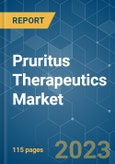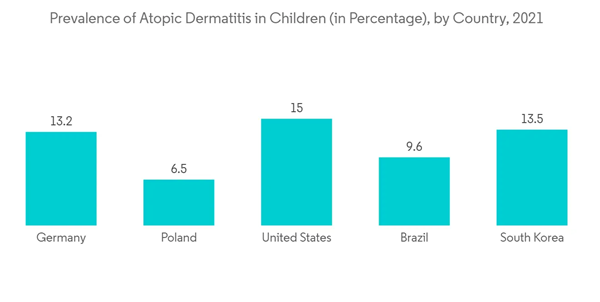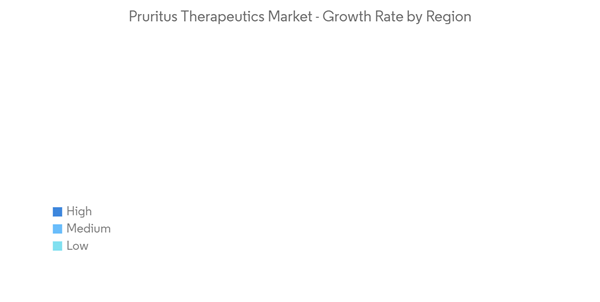The pruritus therapeutics market is expected to grow at a CAGR of 3.5% during the forecast period.
The impact of COVID-19 on the studied market was adverse in the initial phases owing to the cancellations of elective procedures, including treatment of pruritus, which impacted the studied market. For instance, as per the IJCED article, COVID-19 posed unique challenges for all healthcare specialists, including dermatologists, while treating skin conditions, including urticaria, a common dermatological condition. However, the market started to gain traction as treatment facilities and research and development activities to develop innovative therapeutics for pruritus by market players resumed worldwide.
The high prevalence of dermatological diseases like atopic dermatitis, urticaria, cutaneous T-cell, psoriasis, and allergic contact dermatitis and the introduction of novel products to treat the diseases are expected to propel the market growth. In addition, the increasing prevalence of dermatological disorders and the presence of high unmet needs are actively affecting the growth of the studied market.
As per the IJCM article, 20% of the Indian population had skin diseases in 2020. Infections and eczema accounted for two-thirds of the skin diseases in the study population. Also, as per the Life (Basel) Journal, the prevalence of atopic dermatitis was 34% from included studies among Swedish children in 2021. Thus, the high burden of atopic dermatitis or eczema is projected to boost the demand for pruritus therapeutics, as pruritus is an after-effect of these skin diseases.
Additionally, advancements in technology, increasing product approvals, partnerships, and acquisitions by key players are helping in the market growth. For instance, in August 2022, Chugai Pharmaceutical Co. Ltd subsidiary Maruho Co. Ltd launched the anti-IL-31 receptor - a humanized monoclonal antibody Mitchga subcutaneous injection of 60 mg syringes used to alleviate the itching brought on by atopic dermatitis. Mitchga was approved by the Ministry of Health, Labour, and Welfare (MHLW) in March 2022 and listed on the national health insurance (NHI) reimbursement price list in May 2022. Such advancements and developments are likely to boost the demand and usage of pruritus therapeutics in the upcoming year.
Therefore, owing to the aforementioned factors, the studied market is anticipated to witness growth over the analysis period. However, the lack of understanding of disease pathophysiology and the availability of advanced alternative treatment options is likely to impede the market growth.
The corticosteroid segment is expected to increase with the rising geriatric population since the aging population is more prone to chronic skin diseases such as atopic dermatitis and psoriasis. For instance, according to WPP, the population aged 65 years and over in sub-Saharan Africa is 3.0% in 2022 and projected to be 3.3% in 2030; in Northern Africa and Western Asia, it is estimated to be 5.5% in 2022 and projected to be 7.0% in 2030. In Central and Southern Asia, it is estimated to be 6.4% in 2022 and projected to be 8.1% in 2030, and in Europe and Northern America, 18.7% in 2022 and projected to be 22.0% in 2030. Since skin diseases are more common in the geriatric population, the growth of the segment is likely to increase as the population increases.
As per Frontiers, atopic dermatitis (AD) is one of the most frequent inflammatory skin diseases in humans, that affects up to 20% of children and 10% of adults in higher-income countries as of 2021. As of recently, topical corticosteroids (TCS) and calcineurin inhibitors (TCI) are the topical treatments available to treat mild to moderate AD. The high incidence of skin diseases like atopic dermatitis worldwide and the advantages of corticosteroids to treat them are ultimately estimated to augment segment growth.
The advancements in technology and increasing product approvals, along with collaborations and acquisitions by key players, are helping in the market growth. For instance, in August 2020, MC2 Therapeutics, a European company, collaborated with EPI Health, LLC for the co-commercialization of its Wynzora Cream in the US Market. Also, in July 2020, MC2 Therapeutics received Wynzora's USFDA approval for the treatment of Plaque Psoriasis in adults. In addition, MC2 Therapeutics is currently ongoing a phase 2 clinical trial of MC2-25 PAD cream for treating uremic pruritus.
Moreover, in June 2020, Cara Therapeutics, a clinical-stage biopharmaceutical company announced the successful completion of its Phase-II dose-ranging trial of oral Korsuva for moderate to severe chronic kidney disease-associated pruritus and is expected to fuel the competitiveness in the forecast period by its novel and proprietary class of product in the market. Such collaborations and clinical trial developments are anticipated to boost the market growth.
Rising clinical trial activities by market players for atopic dermatitis (AD) are anticipated to boost market growth, as severe AD is associated with pruritus. For instance, in August 2021, Eli Lilly and Company's ADvocate 1 and ADvocate 2 Phase 3 clinical trials showed positive results for lebrikizumab. The medication showed significant improvements, with at least 75% skin clearance in more than half of people with moderate-to-severe atopic dermatitis (AD). The United States Food and Drug Administration (FDA) has granted lebrikizumab (mAb) a fast-track designation for moderate-to-severe AD in adult and adolescent patients. Such developments are anticipated to boost the market growth in the region.
This product will be delivered within 2 business days.
The impact of COVID-19 on the studied market was adverse in the initial phases owing to the cancellations of elective procedures, including treatment of pruritus, which impacted the studied market. For instance, as per the IJCED article, COVID-19 posed unique challenges for all healthcare specialists, including dermatologists, while treating skin conditions, including urticaria, a common dermatological condition. However, the market started to gain traction as treatment facilities and research and development activities to develop innovative therapeutics for pruritus by market players resumed worldwide.
The high prevalence of dermatological diseases like atopic dermatitis, urticaria, cutaneous T-cell, psoriasis, and allergic contact dermatitis and the introduction of novel products to treat the diseases are expected to propel the market growth. In addition, the increasing prevalence of dermatological disorders and the presence of high unmet needs are actively affecting the growth of the studied market.
As per the IJCM article, 20% of the Indian population had skin diseases in 2020. Infections and eczema accounted for two-thirds of the skin diseases in the study population. Also, as per the Life (Basel) Journal, the prevalence of atopic dermatitis was 34% from included studies among Swedish children in 2021. Thus, the high burden of atopic dermatitis or eczema is projected to boost the demand for pruritus therapeutics, as pruritus is an after-effect of these skin diseases.
Additionally, advancements in technology, increasing product approvals, partnerships, and acquisitions by key players are helping in the market growth. For instance, in August 2022, Chugai Pharmaceutical Co. Ltd subsidiary Maruho Co. Ltd launched the anti-IL-31 receptor - a humanized monoclonal antibody Mitchga subcutaneous injection of 60 mg syringes used to alleviate the itching brought on by atopic dermatitis. Mitchga was approved by the Ministry of Health, Labour, and Welfare (MHLW) in March 2022 and listed on the national health insurance (NHI) reimbursement price list in May 2022. Such advancements and developments are likely to boost the demand and usage of pruritus therapeutics in the upcoming year.
Therefore, owing to the aforementioned factors, the studied market is anticipated to witness growth over the analysis period. However, the lack of understanding of disease pathophysiology and the availability of advanced alternative treatment options is likely to impede the market growth.
Pruritus Therapeutic Market Trends
Corticosteroid Segment Expected to Hold Significant Share over the Forecast Period
Corticosteroids are the first-line drug for treating pruritus and are widely used to relieve atopic dermatitis or psoriasis. The segment is expected to witness growth during the forecast period. The increasing demand for over-the-counter topical corticosteroids is expected to be a potential driver for market growth in this segment.The corticosteroid segment is expected to increase with the rising geriatric population since the aging population is more prone to chronic skin diseases such as atopic dermatitis and psoriasis. For instance, according to WPP, the population aged 65 years and over in sub-Saharan Africa is 3.0% in 2022 and projected to be 3.3% in 2030; in Northern Africa and Western Asia, it is estimated to be 5.5% in 2022 and projected to be 7.0% in 2030. In Central and Southern Asia, it is estimated to be 6.4% in 2022 and projected to be 8.1% in 2030, and in Europe and Northern America, 18.7% in 2022 and projected to be 22.0% in 2030. Since skin diseases are more common in the geriatric population, the growth of the segment is likely to increase as the population increases.
As per Frontiers, atopic dermatitis (AD) is one of the most frequent inflammatory skin diseases in humans, that affects up to 20% of children and 10% of adults in higher-income countries as of 2021. As of recently, topical corticosteroids (TCS) and calcineurin inhibitors (TCI) are the topical treatments available to treat mild to moderate AD. The high incidence of skin diseases like atopic dermatitis worldwide and the advantages of corticosteroids to treat them are ultimately estimated to augment segment growth.
North America Expected to Dominate the Pruritus Therapeutics Market over the Forecast Period
North America is expected to dominate the market owing to factors such as the rising incidence of dermatological diseases, the strong presence of industry players in the region, better healthcare infrastructure, and awareness among people and healthcare industry stakeholders about available technologies in the region.The advancements in technology and increasing product approvals, along with collaborations and acquisitions by key players, are helping in the market growth. For instance, in August 2020, MC2 Therapeutics, a European company, collaborated with EPI Health, LLC for the co-commercialization of its Wynzora Cream in the US Market. Also, in July 2020, MC2 Therapeutics received Wynzora's USFDA approval for the treatment of Plaque Psoriasis in adults. In addition, MC2 Therapeutics is currently ongoing a phase 2 clinical trial of MC2-25 PAD cream for treating uremic pruritus.
Moreover, in June 2020, Cara Therapeutics, a clinical-stage biopharmaceutical company announced the successful completion of its Phase-II dose-ranging trial of oral Korsuva for moderate to severe chronic kidney disease-associated pruritus and is expected to fuel the competitiveness in the forecast period by its novel and proprietary class of product in the market. Such collaborations and clinical trial developments are anticipated to boost the market growth.
Rising clinical trial activities by market players for atopic dermatitis (AD) are anticipated to boost market growth, as severe AD is associated with pruritus. For instance, in August 2021, Eli Lilly and Company's ADvocate 1 and ADvocate 2 Phase 3 clinical trials showed positive results for lebrikizumab. The medication showed significant improvements, with at least 75% skin clearance in more than half of people with moderate-to-severe atopic dermatitis (AD). The United States Food and Drug Administration (FDA) has granted lebrikizumab (mAb) a fast-track designation for moderate-to-severe AD in adult and adolescent patients. Such developments are anticipated to boost the market growth in the region.
Pruritus Therapeutic Market Competitor Analysis
The pruritus therapeutics market is fragmented due to the presence of many companies operating globally and regionally. The competitive landscape includes an analysis of a few international and local companies that hold market shares and are well known. Some key players are Actavis, AbbVie Inc., Astellas Pharma Inc., Cara Therapeutics, EPI Health LLC, Galderma Laboratories LP, Ocera Therapeutics Inc., and Pfizer Inc., Sanofi, Trevi Therapeutics, among others.Additional benefits of purchasing the report:
- The market estimate (ME) sheet in Excel format
- 3 months of analyst support
This product will be delivered within 2 business days.
Table of Contents
1 INTRODUCTION
4 MARKET DYNAMICS
5 MARKET SEGMENTATION (Market Size by Value - USD million)
6 COMPETITIVE LANDSCAPE
Companies Mentioned (Partial List)
A selection of companies mentioned in this report includes, but is not limited to:
- Actavis
- AbbVie Inc.
- Astellas Pharma Inc.
- Cara Therapeutics
- EPI Health LLC
- Galderma Laboratories LP
- Ocera Therapeutics Inc.
- Pfizer Inc.
- Sanofi
- Trevi Therapeutics
Methodology

LOADING...









